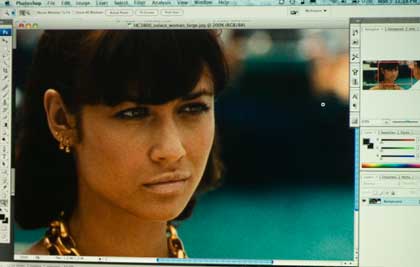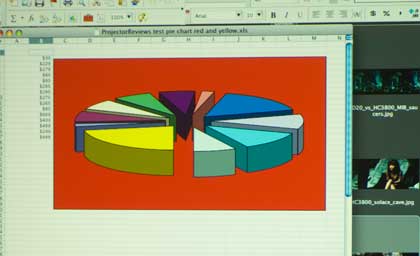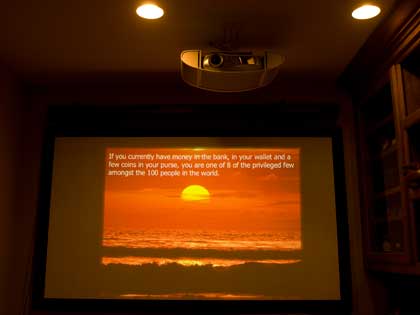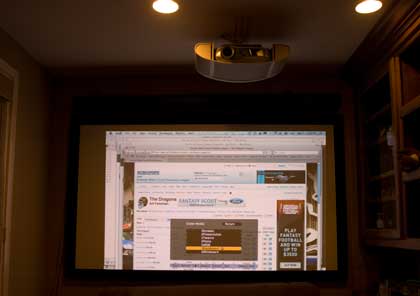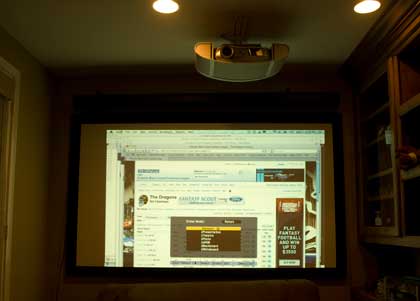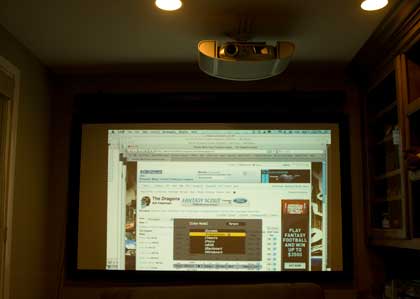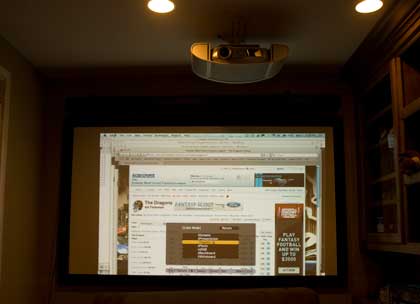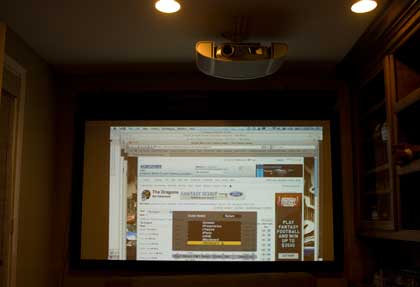Epson Powerlite 826W Color & Picture Quality
In evaluating the Powerlite 826W we start with one of the most likely uses - computer presentations, I connected the 826W to my laptop via the analog VGA connection and fed it at its native resolution (1280 x 800).
As we've mentioned in past Epson projector reviews, greens leaned slightly toward yellow and reds and blues were a bit oversaturated, but this common for LCD projectors, and these shifts are visibly very slight. Note the colors in the pie chart below, look very good:
By contrast, much of the DLP competition has reds that are visibly way too dark and yellows that lean toward green, so they don't tend to look as colorful or accurate as the 826W. The 826W displayed a nice clean image with well-saturated colors for photographic images, as well as graphics. Text and graphs were quite sharp as well (see "Sharpness" under the General Performance for more detail on this).
Viewing photographic images with the 826W was also quite good. Using Photo mode resulted in excellent picture brightness, with deep, rich colors. This provides a very natural appearance to photo presentations.
I then switched to the USB input (again fed from my laptop) and there was no discernable difference from the standard VGA connection.
Epson Powerlite 826W Projector - Video Performance
To check out the 826W’s video performance, I used the DVD playback from my laptop, as well as a standalone DVD player feeding the 826W via S-video. As we’ve come to expect from Epson’s 3LCD projectors, video from any source looks very clean, with well-saturated colors. Using the same DVD in each, I didn’t notice any difference in picture quality between the two video sources.
The Theater mode of the 826W can make use an auto iris, which when active, results in an improved contrast ratio (up to 2000:1). While a 2000:1 contrast ratio is low among home theater projectors, it is a decent ratio for a projector this bright and can contributes to a more film-like image than is normally seen with multimedia projectors. The auto iris is also available in Dynamic mode as well.
Use of the auto iris does help to improve the otherwise grayish blacks in mixed light scenes with most video sources. When faced with a movie with a majority of dark scenes, the 826W falls short in comparison with similarly priced home theater projectors, but none of them offer the brightness of the 826W. For daytime TV or video viewing (like sports events), the extra brightness of the 826W provides for a highly watchable picture that is not washed out, as most home theater projectors would be.
While the 826W is not designed to be used for movie or TV viewing, it’s nice to know that it certainly could be used for that in a pinch, while still providing solid picture quality.
Epson Powerlite 826W Projector - Brightness
The 826W is rated at 2500 lumens. Our experience with other Epson projectors is that they usually achieve or come close to their rated specification. So, we expected the 826W to perform well and it did. In Dynamic mode (the brightest), we measured 2136 lumens at mid-zoom range. The output varied slightly throughout the zoom range, but was still very bright. At full wide zoom, we got 2225 lumens and at full telephoto zoom it was 1940 lumens. All further measurements were taken at the mid-zoom point. Using Presentation mode, the output dropped to 1753 lumens. Photo mode and sRGB modes were nearly identical for lumen output at 1540 and 1529 lumens respectively. Theater mode, which provided the best contrast between dark and light scenes for movie and video viewing, was still quite bright at 1517 lumens. Finally, Blackboard and Whiteboard (specifically designed color balances to work with school blackboards and dry erase-type whiteboards) came in at 1491 and 1357 lumens respectively. Overall, the 826W has plenty of punch for its intended markets, the classroom and conference room.
Below are a series of images taken at the same exposure, showing the different brightness and feel of different modes. From top to bottom: Dynamic, Presentation, Theater, Blackboard, and Whiteboard modes Notably missing is Photo Mode, of which you will find an excellent image on the Image Quality page. These images are all taken projecting approximately a 6 foot wide image under full room lighting.
Dropping the lamp into Low brightness mode resulted in a lumen output of 1716 in Dynamic mode. This is about a 20% drop, which is still quite bright, and only a few lumens less than Presentation mode on High lamp.
Sharpness
The 826W provided a very sharp, clean image with our usual variety of source material. Bringing up our usual spreadsheet with a range of text sizes and colors, small (8 pt.) text was easily readable on a 90” diagonal projected image. This was also true of white text-on-black and yellow text-on-dark blue backgrounds as well.
The 826W also did not have a problem handling higher resolutions. Switching to 1600 x 1200 to test its ability to scale and resize these resolutions, the 826W handled the text spreadsheet as if it was at its native resolution. Some projectors, when fed higher-than-native resolutions, have difficulty accurately displaying the different colored text/background combinations in the spreadsheet. Combining that with a different aspect ratio as well can play havoc with the projector’s compression circuitry. This was not the case with the 826W, which did an excellent job with both. Small text remained sharp and readable.
There was only the slightest color separation or overlap and that was only with the smaller text. To keep perspective, one would rarely project anything smaller than 12 point type (maybe 10) and expect anyone in the room to be able to read it. In formal presentation, such as the typical Powerpoint presentation, small type is considered 18 point, and most bullet points are 24 to 36 points, and titles 48 points and larger.
Finally, the 826W also did an excellent job on lower resolutions, like the old standard XGA (1024 x 768) resolution. Overall, an excellent performance for any projector, much less one in the 826W’s price range.
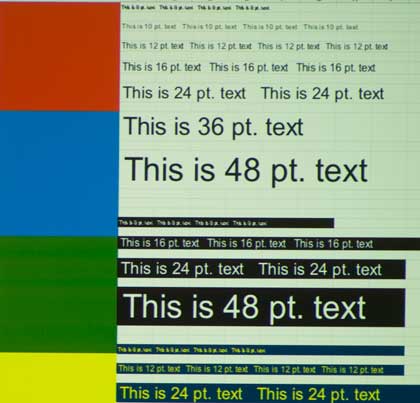 Click Image to Enlarge
Click Image to Enlarge
